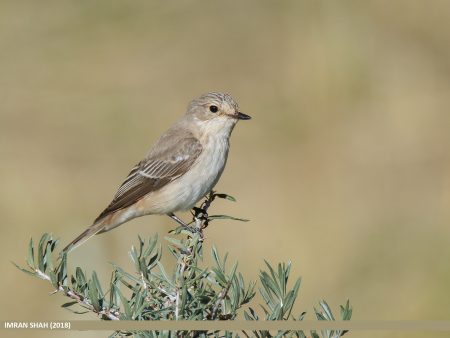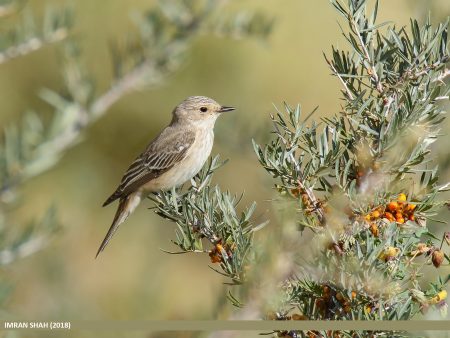A spotted flycatcher call includes a thin, squeaky ‘zeee’, a sharp ‘chick’, and a ‘zee-zucc’ of alarm. Bill snaps when fly-catching. The Spotted Flycatcher song is a weak and inconspicuous series of squeaky notes, often with quite long intervals between phrases, e.g., ‘tsee, chup chup, chup, tseee, tseee, chup-tsee-chup, tsee’. Spotted Flycatcher calls from the perch, flicking wings and tails as it does so. It has strong flight and is quite bounding when moving over long distances.
The size of the Spotted Flycatcher (Muscicapa striata) is about 13–14 cm in length. The spotted flycatcher is a drab gray-brown little bird, but its upright stance, relatively large head with a flat (or slightly peaked) crown, relatively long wings, and fly-catching habits betray its identity. The English name is a little confusing: the adult is not fully spotted (whereas all flycatcher juveniles are noticeably spotted)! ‘Striated Flycatcher’ would be more appropriate.
Drab coloration plus the fine dark streaking on the crown, throat, and breast are diagnostic, although the streaks on the crown are visible only given good views. The blackish bill shows only a very small amount of pale at the base of the lower mandible. In fresh plumage, narrow pale fringes to wing feathers are often prominent, suggesting a pied flycatcher complex, but Spotted lacks white in tail and visible streaking on foreparts. Habitually, flycatchers depart from and return to the same perch, flying out in a broad, sweeping arc, turning with spread wings and tails to return to the perch.
Spotted Flycatchers habitually feed from perches at mid-tree level, towards the outside of the tree, rather than inside the canopy. The juvenile bird has prominent buff spotting above and dark mottling below. First-winter birds in late summer and autumn may be aged by more conspicuous pale fringes on wing feathers and a fairly prominent buffish wing bar on greater coverts.
As per geographical variation, there are five races (nominate, neumanni and tyrrhenica illustrated). Variation mainly clinal: neumanni of Crete, Turkey, and W Siberia eastwards is paler and greyer above and whiter below than the nominate race; inexpecta of the Crimea is darker and browner above and more prominently streaked; balearica of the Balearic is very pale and rather sandy above; and tyrrhenica of Corsica and Sardinia is warmer brown with indistinct streaking.
The spotted flycatcher is a common bird and is found in woodland edges, glades and clearings, open woodland (both deciduous and coniferous), parks, orchards, and large gardens.
Read More: Loggerhead Shrikes Call










